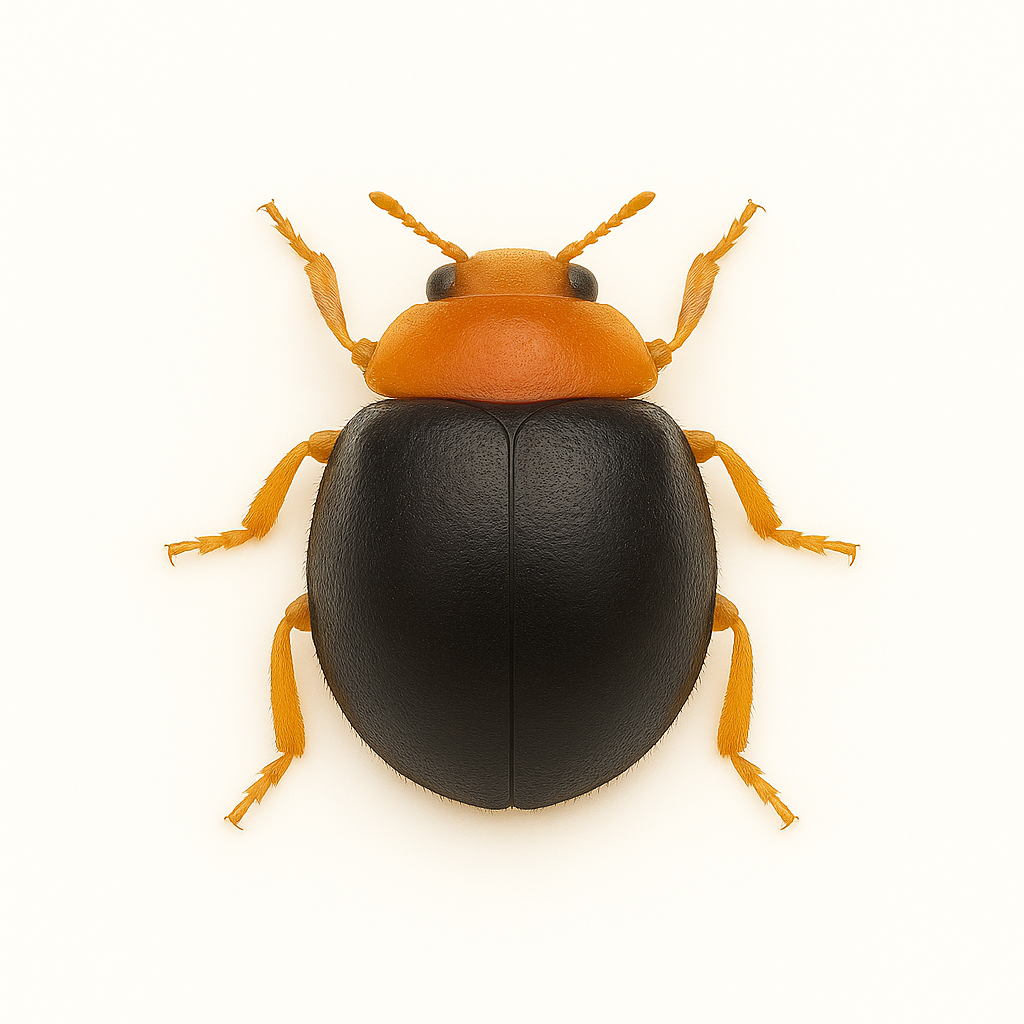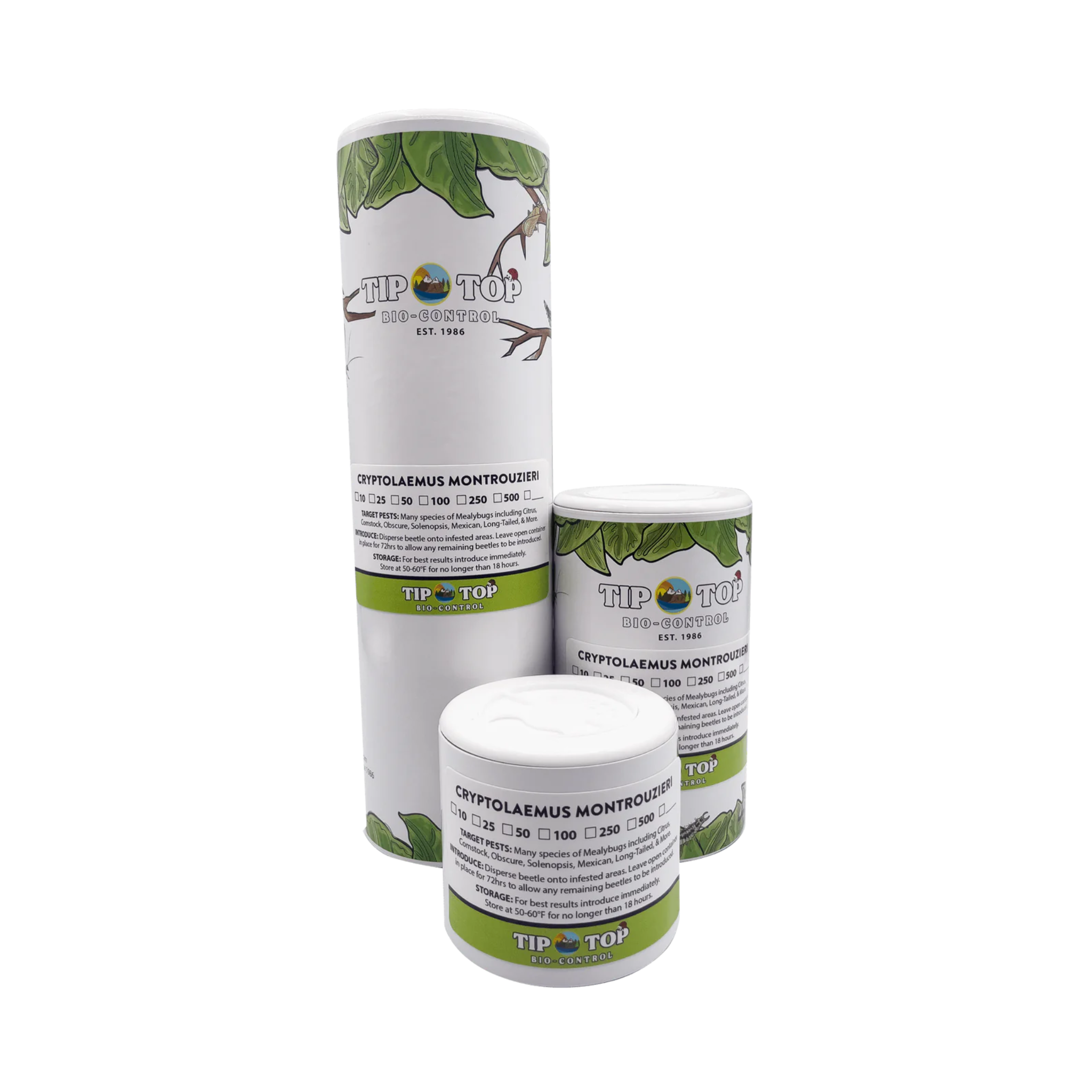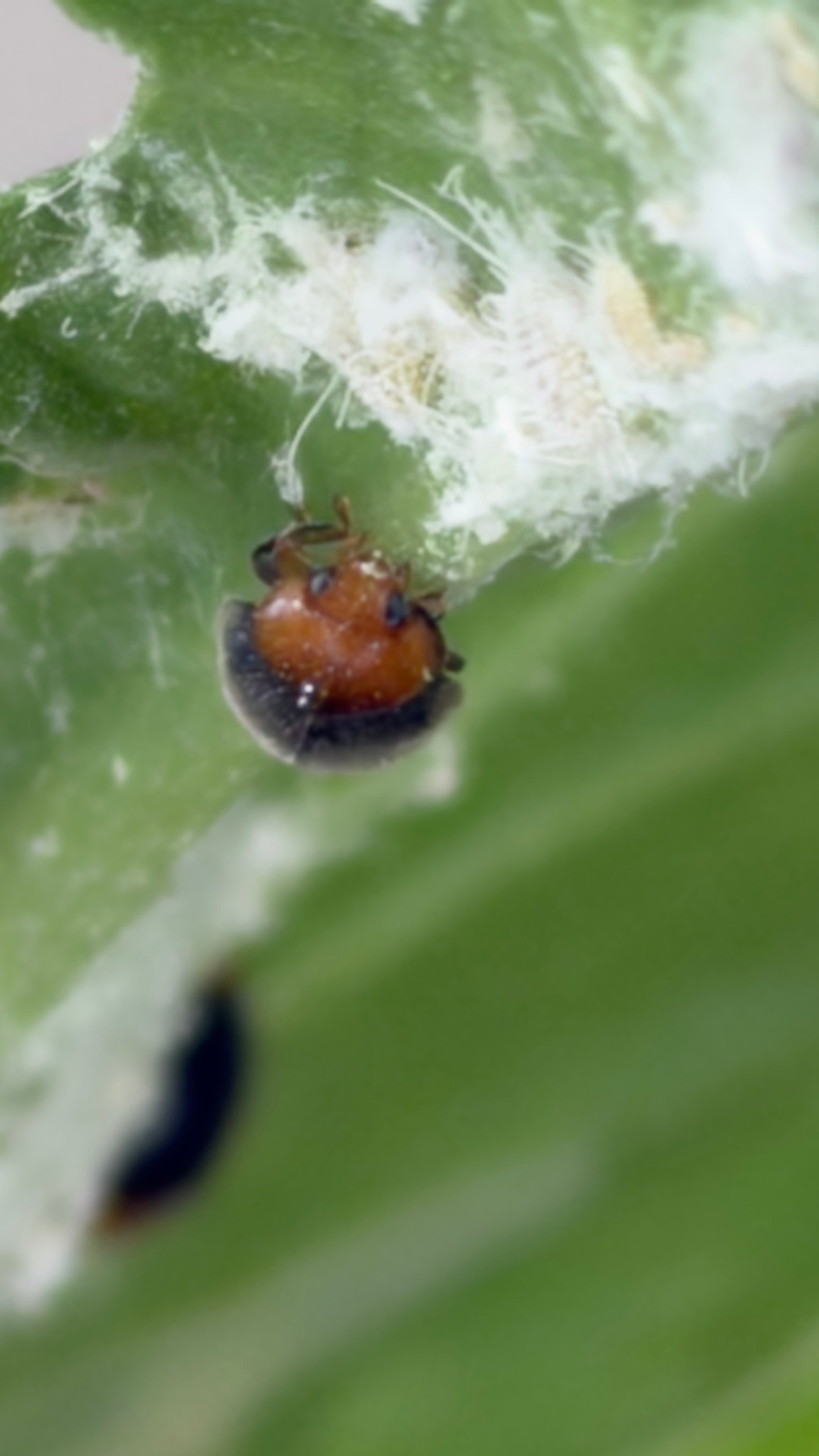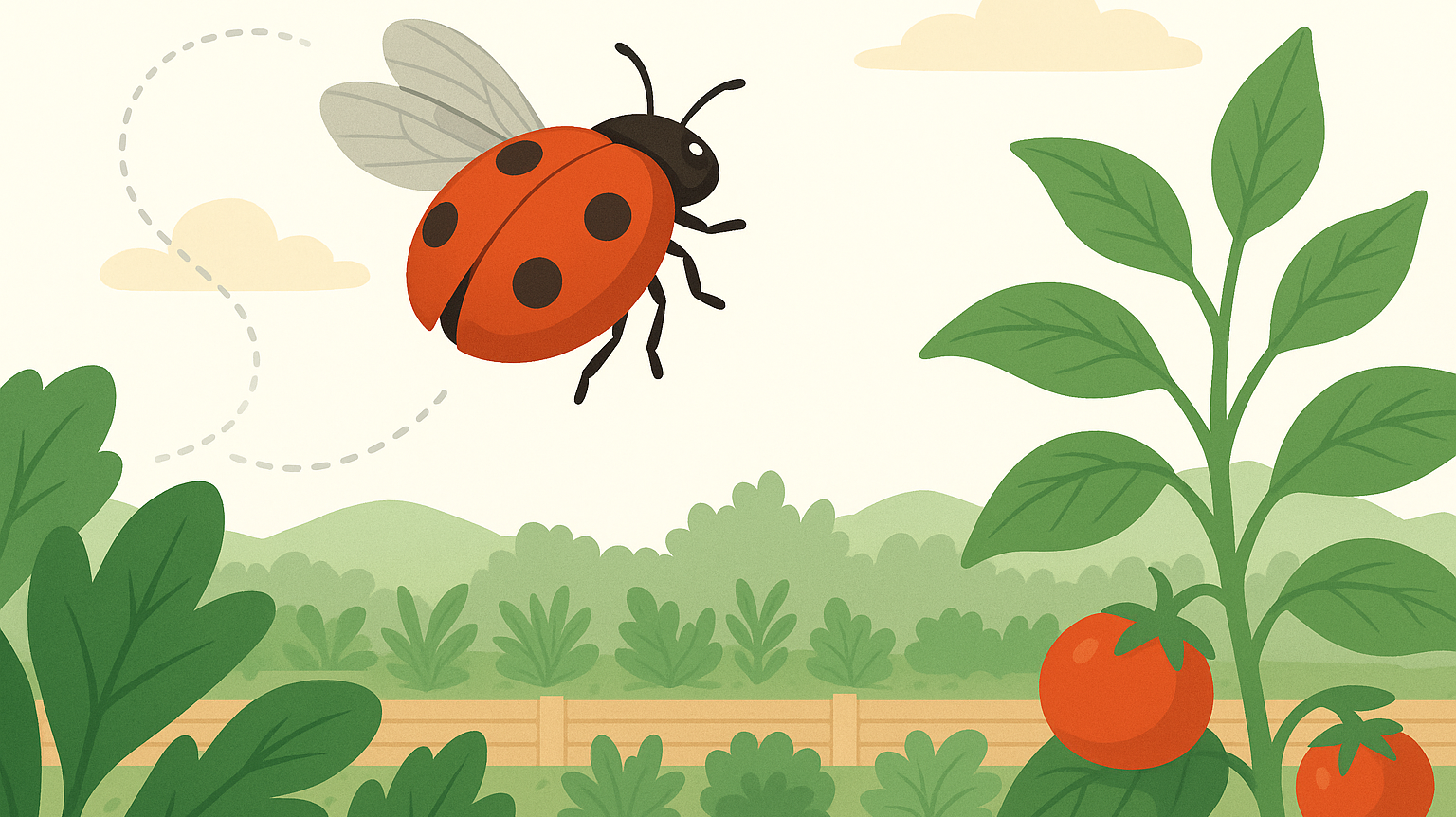Tried Sprays and Swabs, but the Mealybugs Keep Coming Back?
You’re not just dealing with the ones you see—you’re dealing with a colony.
Eggs tucked in leaf joints. Crawlers under petioles. Adults you didn’t spot until it was too late.
Cryptolaemus montrouzieri is the predator built for this. These live adult beetles don’t nibble. They clean house—hunting and feeding on mealybugs at every stage, without sprays, residue, or second guesses.
Cryptolaemus montrouzieri (Live Adult Mealybug Destroyers)
Biological Control for Mealybugs and Soft Scale Crawlers
This bottle contains live adult Cryptolaemus beetles—fast-moving, mealybug-seeking predators that feed on eggs, crawlers, and adult mealybugs.
They’re dark brown with orange heads (ladybug-sized) and built to move. Unlike slow-release systems or foliar sprays, these beetles actively seek out mealybug hotspots and reduce populations quickly.
What They Treat
| Pest | Stage Targeted |
|---|---|
| Citrus mealybugs | Eggs, nymphs, adults |
| Comstock mealybugs | Full lifecycle |
| Long-tailed mealybugs | All stages |
| Other mealybug species | Broad efficacy |
| Soft scale (crawler stages) | Opportunistic feeding |
Note: Best results when applied early or at first signs of infestation. For prevention, consider pairing with slow-release predators.
Why It Works
| Feature | Why It Matters |
|---|---|
| Full lifecycle suppression | Eats eggs, crawlers, and adults |
| Immediate feeding | Adults start hunting right away |
| High visibility | Easy to monitor impact |
| No chemical residue | Clean option for edibles and sensitive plants |
| Scalable | Works in small setups or full greenhouses |
When to Use
-
You’ve got a confirmed mealybug problem, not just a suspicion
-
Sprays haven’t worked—or the pests came right back
-
You want results in 7–10 days
-
Your space stays above 50°F (these don’t survive cold)
How to Use
-
Gently rotate the bottle before opening
-
Release beetles directly onto infested plants
-
Focus on areas where mealybugs cluster—leaf nodes, undersides, stem joints
-
Release early morning or evening (avoid heat or direct sun)
-
Avoid spraying before or after application—residues kill predators
How Many to Use
| Infestation Level | Suggested Rate |
|---|---|
| Light | 1–2 beetles per square foot |
| Heavy | 2–4 beetles per square foot |
| Greenhouse-scale | 1,000–2,000 beetles per acre |
Apply weekly during active infestations, or as needed based on population rebound.
Safe for Everything but the Pests
-
No residue
-
Non-toxic to people, pets, pollinators, or plants
-
Compatible with organic and regenerative systems
-
Fully IPM-integrated
-
No re-entry wait time
Pro Tips
-
Use immediately—these are live adults
-
If necessary, store short-term at 45–55°F (18 hours max)
-
Reapply after frost, temperature drops, or pest rebounds
-
Pair with monitoring traps or slower-release predators for ongoing coverage
-
Don’t wait until populations explode—apply early when mealybugs first appear
Shipping & Storage
-
Ships overnight with live delivery guarantee
-
Use immediately upon arrival
-
If needed, store for up to 18 hours at 45–55°F
-
Do not freeze, overheat, or expose to dry air
FAQ
How does the Live Guarantee work?
We know how important it is for your mites to arrive healthy and ready to work. That’s why we offer a live arrival guarantee—with flexible options depending on when we hear from you:
- Let us know within 24 hours of delivery: We’ll gladly send a free replacement shipment.
- Let us know within 2–3 days of delivery: We can offer store credit to make things right.
- After 3 days from delivery: Because these are living organisms, we’re not able to offer replacements or credit beyond that window. By then, it’s harder to know what went wrong or whether shipping conditions were a factor.
We truly want your mites to succeed—so please open your package as soon as it arrives and check on them. If something doesn’t look right, don’t wait—reach out and we’ll take care of you.
Where are you located?
We have a number of different locations in NJ, Maine and Oregon. While we'd love to have you, we are not currently open to the public.
Can I call you?
We get it. Sometimes it's easier to talk to someone, and on a case by case basis we can try to figure it out. Unfortunately though, we're really not able to take calls—FGMN is a small nursery, and we're usually elbows-deep in plants or packing boxes. To make sure nothing gets missed (and everyone gets a timely reply), we keep all communication in writing.
Feel free to message us at info@fgmnnursery.com. We mostly respond quickly, but every once in awhile replies may take a day. Do follow-up if you don't hear in that time. We're human, we miss an email here or there.
Too Many Options?
We get it. Try our mite/insect matchmaking quiz and instantly get matched to the solutions you may need.
Our Live Delivery Guarantee
We stand behind every leaf and every mite. If your plant or predatory insects don’t arrive alive on the first delivery attempt, we’ll make it right.
Here’s what you need to know:
- Email us at info@fgmnnursery.com within 24 hours of delivery
- Include clear photos of the item and the shipping label
- Someone must be available to receive the package—plants and bugs don’t do well sitting in the sun, a mailbox, or the back of a delivery truck
For plants, we offer store credit if something goes wrong.
For predatory mites and beneficial insects, you’ll have the choice of a replacement shipment or store credit.
If you contact us after the 24-hour window, we may still be able to help—just know it’s handled case by case.
We pack with care, insulate when needed, and check the weather before shipping. But once it’s in transit, the fastest way to protect your order is to open it right away.
Mite Matters
The Hidden Weather That Shapes Plant and Predator Life
Invisible weather shapes every growing space. Warm air pools under lights, cool air settles near the floor, and in between, tiny predators decide where they’ll thrive. Learn how microclimates influence the balance between plants, pests, and the mites that keep them in check.
If Ladybugs Are Just Going to Fly Away, Why Use Them?
Most ladybugs don’t fly off out of spite — they leave when the environment isn’t right. Learn how temperature, humidity, and shelter affect whether they settle or scatter, and how to create the ideal setup that keeps them working where you need them most.
Where Did My Predatory Mites Go?
Released predatory mites but can’t see them anymore? Don’t panic. Their invisibility is exactly what makes them effective. Learn why they vanish, how they hunt pests out of sight, and why reapplying keeps your plants protected.









